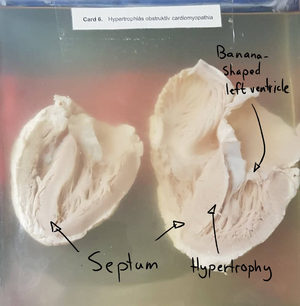48. Hypertrophic cardiomyopathy
Organ: Heart
Description:
Two heart sections can be seen (from separate hearts). On both sections, but especially on the right, the septum is severely thickened, to the point where it bulges into the left ventricle. The left ventricle ends up with a banana-shaped lumen.
Diagnosis: Obstructive type of hypertrophic cardiomyopathy
Causes:
- Genetic mutations
Theory:
In hypertrophic cardiomyopathy is the heart as a whole hypertrophied, however the septum is 3x as hypertrophied as the rest. This causes the septum to become severely thickened and bulge into the left ventricle.
1/3 of hypertrophic cardiomyopathies are of the obstructive type, where the septum can suddenly (and reversibly) obstruct the left ventricular outflow tract (LVOT), which causes the blood pressure to drop so significantly that syncope occurs. The obstruction is transient and reversible. Sudden syncope is a characteristic finding in patients with obstructive hypertrophic cardiomyopathy. The obstruction most likely occurs due to negative pressure forming in the LVOT, which pulls the mitral valve toward the septum. This is called systolic anterior motion and is due to the Venturi effect (not important to know the exact mechanism).

